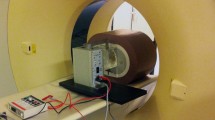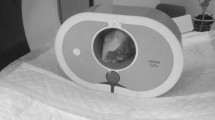Abstract.
Electron beam tomography (EBT) has been used for cardiac diagnosis and the quantitative assessment of coronary calcium since the late 1980s. The introduction of mechanical multi-slice spiral CT (MSCT) scanners with shorter rotation times opened new possibilities of cardiac imaging with conventional CT scanners. The purpose of this work was to qualitatively and quantitatively evaluate the performance for EBT and MSCT for the task of coronary artery calcium imaging as a function of acquisition protocol, heart rate, spiral reconstruction algorithm (where applicable) and calcium scoring method. A cardiac CT semi-anthropomorphic phantom was designed and manufactured for the investigation of all relevant image quality parameters in cardiac CT. This phantom includes various test objects, some of which can be moved within the anthropomorphic phantom in a manner that mimics realistic heart motion. These tools were used to qualitatively and quantitatively demonstrate the accuracy of coronary calcium imaging using typical protocols for an electron beam (Evolution C-150XP, Imatron, South San Francisco, Calif.) and a 0.5-s four-slice spiral CT scanner (Sensation 4, Siemens, Erlangen, Germany). A special focus was put on the method of quantifying coronary calcium, and three scoring systems were evaluated (Agatston, volume, and mass scoring). Good reproducibility in coronary calcium scoring is always the result of a combination of high temporal and spatial resolution; consequently, thin-slice protocols in combination with retrospective gating on MSCT scanners yielded the best results. The Agatston score was found to be the least reproducible scoring method. The hydroxyapatite mass, being better reproducible and comparable on different scanners and being a physical quantitative measure, appears to be the method of choice for future clinical studies. The hydroxyapatite mass is highly correlated to the Agatston score. The introduced phantoms can be used to quantitatively assess the performance characteristics of, for example, different scanners, reconstruction algorithms, and quantification methods in cardiac CT. This is especially important for quantitative tasks, such as the determination of the amount of calcium in the coronary arteries, to achieve high and constant quality in this field.







Similar content being viewed by others
References
World Health Organization (1999) The World Health Report 1999: making a difference. World Health Organization, Geneva
Kennedy J (1982) Complications associated with cardiac catheterization and angiography. Catheter Cardiovasc Diagn 8:5–11
O'Rourke R, Brundage B, Froelicher V, Greenland P, Grundy S, Hachamovitch R, Pohost G, Shaw L, Weintraub W, Winters JWL (2000) American College of Cardiology/American Heart Association Expert Consensus Document on electron-beam computed tomography for the diagnosis and prognosis of coronary artery disease. J Am Coll Cardiol 36:326–340
Little W, Constantinescu M, Applegate R, Kutcher M, Burrows M, Kahl F, Santamore W (1988) Can coronary angiography predict the site of a subsequent myocardial infarction in patients with mild-to-moderate coronary artery disease? Circulation 78:1157–1166
Ambrose J, Fuster V (1998) The risk of coronary occlusion is not proportional to the prior severity of coronary stenoses. Heart 79:34
Arad Y, Spadaro L, Goodman K, Newstein D, Guerci A (2000) Prediction of coronary events with electron beam computed tomography. J Am Coll Cardiol 36:1253–1260
Raggi P, Callister T, Cooil B, He Z, Lippolis N, Russo D, Zelinger A, Mahmarian J (2000) Identification of patients at increased risk of first unheralded acute myocardial infarction by electron-beam computed tomography. Circulation 101:850–855
Wexler L, Brundage B, Crouse J, Detrano R, Fuster V, Maddahi J, Rumberger J, Stanford W, White R, Taubert K (1996) Coronary artery calcification: pathophysiology, epidemiology, imaging methods, and clinical implications. A statement for health professionals from the American Heart Association. Writing Group. Circulation 94:1175–1192
Stanford W, Thompson B, Weiss R (1993) Coronary artery calcification: clinical significance and current methods of detection. Am J Roentgenol 161:1139–1146
Agatston A, Janowitz W, Hildner F, Zusmer N, Viamonte M, Detrano R (1990) Quantification of coronary artery calcium using ultrafast computed tomography. J Am Coll Cardiol 15:827–832
Bielak L, Sheedy n PF, Peyser P (2001) Coronary artery calcification measured at electron-beam CT: agreement in dual scan runs and change over time. Radiology 218:22–49
Achenbach S, Ropers D, Mohlenkamp S, Schmermund A, Muschiol G, Groth J, Kusus M, Regenfus M, Daniel W, Erbel R, Moshage W (2001) Variability of repeated coronary artery calcium measurements by electron beam tomography. Am J Cardiol 87:210–213
Becker C, Knez A, Ohnesorge B, Schöpf U, Flohr T, Bruening R, Haberl R, Reiser M (2000) Visualization and quantification of coronary calcifications with electron beam and spiral computed tomography. Eur Radiol 10:629–635
Devries S, Wolfkiel C, Shah V, Chomka E, Rich S (1995) Reproducibility of the measurement of coronary calcium with ultrafast computed tomography. Am J Cardiol 75:973–975
Hernigou A, Challande P, Boudeville J, Séné V, Grataloup C, Plainfossé M (1996) Reproducibility of coronary calcification detection with electron-beam computed tomography. Eur Radiol 6:2106
Shields J, Mielke C, Rockwood T, Short R, Viren F (1995) Reliability of electron beam computed tomography to detect coronary artery calcification. Am J Card Imaging 9:62–66
Wang S, Detrano R, Secci A, Tang W, Doherty T, Puentes G, Wong N, Brundage B (1996) Detection of coronary calcification with electron-beam computed tomography: evaluation of interexamination reproducibility and comparison of three image-acquisition protocols. Am Heart J 132:550–558
Yoon H, Greaser L, Mather R, Sinha S, McNitt-Gray M, Goldin J (1997) Coronary artery calcium: alternate methods for accurate and reproducible quantitation. Acad Radiol 4:666–673
Shemesh J, Tenenbaum A, Kopecky K, Apter S, Rozenman J, Itzchak Y, Motro M (1997) Coronary calcium measurements by double helical computed tomography. Using the average instead of peak density algorithm improves reproducibility. Invest Radiol 32:50–36
Broderick L, Shemesh J, Wilensky R, Eckert G, Zhou X, Torres W, Balk M, Rogers W, Conces J DJ, Kopecky K (1996) Measurement of coronary artery calcium with dual-slice helical CT compared with coronary angiography: evaluation of CT scoring methods, interobserver variations, and reproducibility. Am J Roentgenol 167:439–444
McCollough C, Kaufmann R, Cameron B, Katz D, Sheedy P II, Peyser P (1995) Electron-beam CT: use of a calibration phantom to reduce variability in calcium quantification. Radiology 196:159–165
Becker C, Knez A, Jakobs T, Aydemir S, Becker A, Schöpf U, Bruening R, Haberl R, Reiser M (1999) Detection and quantification of coronary artery calcification with electron-beam and conventional CT. Eur Radiol 9:62–04
Shemesh J (1994) Spiral methods quantify coronary calcification. Computed Tomography :30–32
Shemesh J, Apter S, Rozenman J, Lusky A, Rath S, Itzchak Y, Motro M (1995) Calcification of coronary arteries: detection and quantification with double-helix CT. Radiology 197:779–783
Shemesh J, Fisman E, Tenenbaum A, Apter S, Leibovitch L, Rath S, Itzchak Y, Motro M (1997) Coronary artery calcification in women with syndrome X: usefulness of double-helical CT for detection. Radiology 205:697–700
Shemesh J, Tenenbaum A, Fisman E, Apter S, Rath S, Rozenman J, Itzchak Y, Motro M (1996) Absence of coronary calcification on double-helical CT scans: predictor of angiographically normal coronary arteries in elderly women? Radiology 199:66–58
Kalender W (2001) Computed tomography. Wiley, New York
Kachelriess M, Kalender W (1997) ECG-based phase-oriented reconstruction from subsecond spiral CT scans of the heart. Radiology 205:215
Kachelriess M, Kalender W (1998) ECG-correlated image reconstruction from subsecond spiral CT scans of the heart. Med Phys 25:2417–2431
Kachelriess M, Kalender W (1998) Imaging of the heart by ECG-oriented reconstruction from subsecond spiral multi-row detector CT scans. Radiology 209:323
Kachelriess M, Kalender W, Karakaya M, Achenbach S, Nossen J, Moshage W, Bautz W (1998) Imaging of the heart by ECG-oriented reconstruction from subsecond spiral CT scans. In: Glazer G, Krestin G (eds) Advances in CT, vol IV. Springer, Berlin Heidelberg New York, pp 137–143
Kachelriess M, Kalender W (1999) ECG-correlated image reconstruction from subsecond multirow spiral CT scans of the heart: theoretical considerations, phantom measurements and patient studies. Radiology 213:401
Kachelriess M, Kalender W (1999) ECG-based phase oriented image reconstruction from subsecond spiral multi-row CT scans of the heart. Eur Radiol 9:277
Kachelriess M, Ulzheimer S, Kalender W (1999) EKG-basierte phasenorientierte Bildrekonstruktion aus Subsekunden-Mehrzeilen-Spiral-CT-Aufnahmen des Herzens. Rofo Fortschr Geb Röntgenstr Neuen Bildgeb Verfahr (Suppl) 170:174–175
Kachelriess M, Ulzheimer S, Kalender W (2001) Neue Entwicklungen in der Computertomographie: EKG korrelierte Subsekunden-Mehrschicht-Spiral-CT. Röntgenpraxis
Kachelriess M, Ulzheimer S, Kalender W (2000) ECG-correlated image reconstruction from subsecond multi-slice spiral CT scans of the heart. Med Phys 27:1881–1902
Kachelriess M, Ulzheimer S, Kalender W (2000) ECG-correlated imaging of the heart with subsecond multislice spiral CT. IEEE Trans Med Imaging 19:888–901
Ulzheimer S, Kachelriess M, Kalender W (1999) Improvements of cardiac CT using ECG-oriented image reconstruction in subsecond spiral multirow scanning. Eur Radiol 9 (Suppl 1):419
Ulzheimer S, Decker R, Kachelriess M, Kalender W (2000) Quality assurance in cardiac CT: phantoms for scanner calibration and comparison of different imaging parameters. Eur Radiol 10 (Suppl 1):303–304
Ulzheimer S (2001) Cardiac imaging with X-ray computed tomography: new approaches to image acquisition and quality assurance. Reports from the Institute of Medical Physics, University of Erlangen-Nürnberg. Shaker, Aachen
Kalender W, Felsenberg D, Genant H, Fischer M, Dequeker J, Reeve J (1995) The European Spine Phantom: a tool for standardization and quality control in spinal bone mineral measurements by DXA and QCT. Eur J Radiol 20:83–92
Kalender W, Süss C, Faust U (1988) Polyethylene-based water- and bone-equivalent materials for calibration phantoms in quantitative computed tomography. Biomed Tech Berl 33:73–76
Schmermund A, Baumgart D, Gorge G, Seibel R, Gronemeyer D, Ge J, Haude M, Rumberger J, Erbel R (1997) Coronary artery calcium in acute coronary syndromes: a comparative study of electron-beam computed tomography, coronary angiography, and intracoronary ultrasound in survivors of acute myocardial infarction and unstable angina. Circulation 96:1461–1469
Ohnesorge B, Flohr T, Becker C, Knez A, Kopp A, Fukuda K, Reiser M (2000) Cardiac imaging with rapid, retrospective ECG synchronized multilevel spiral CT. Radiologe 40:111–117
Ohnesorge B, Flohr T, Becker C, Kopp A, Schöpf U, Baum U, Knez A, Klingenbeck-Regn K, Reiser M (2000) Cardiac imaging by means of electrocardiographically gated multisection spiral CT: initial experience. Radiology 217:564–571
Ohnesorge B, Becker C, Flohr T, Reiser M (2002) Multi-slice CT in cardiac imaging. Springer, Berlin Heidelberg New York
Hoffmann J (2000) Taschenbuch der Messtechnik, 2nd edn. Fachbuchverlag, Leipzig
Achenbach S, Ulzheimer S, Baum U, Kachelriess M, Ropers D, Giesler T, Bautz W, Daniel W, Kalender W, Moshage W (2000) Non-invasive coronary angiography by retrospectively ECG-gated multislice spiral CT. Circulation 102:2823–2828
Acknowledgements.
We thank our colleagues from the Department of Cardiology, especially S. Achenbach and D. Ropers, and from the Department of Diagnostic Radiology, for a good and pleasant collaboration. S. Achenbach supplied us with the cardiac 4D motion functions determined from angiography data. Parts of this work were supported by grants from the Bayerische Forschungsstiftung (AZ 262/98 and AZ 322/99). We also thank the reviewers for their constructive comments which helped to improve the manuscript.
Author information
Authors and Affiliations
Corresponding author
Rights and permissions
About this article
Cite this article
Ulzheimer, S., Kalender, W.A. Assessment of calcium scoring performance in cardiac computed tomography. Eur Radiol 13, 484–497 (2003). https://doi.org/10.1007/s00330-002-1746-y
Received:
Revised:
Accepted:
Published:
Issue Date:
DOI: https://doi.org/10.1007/s00330-002-1746-y




